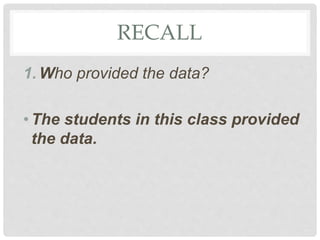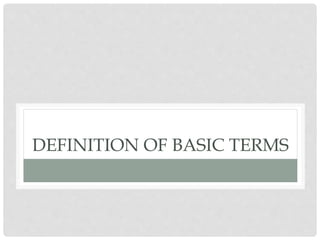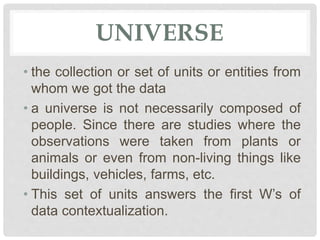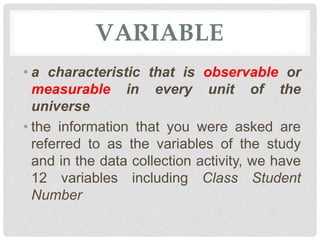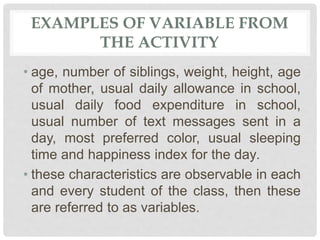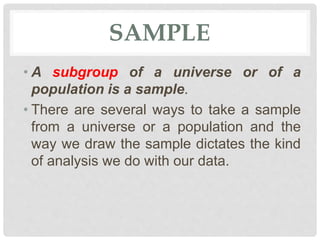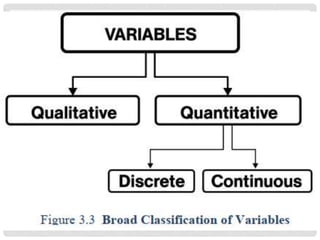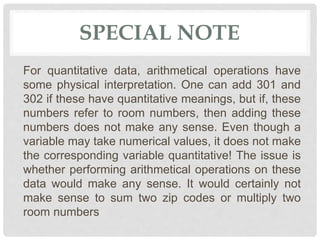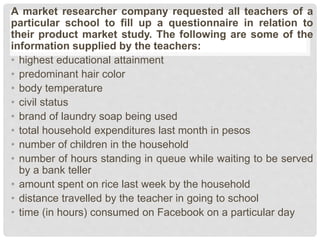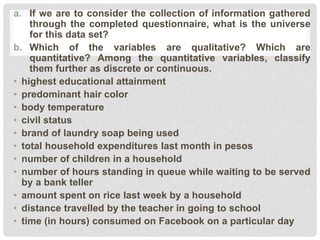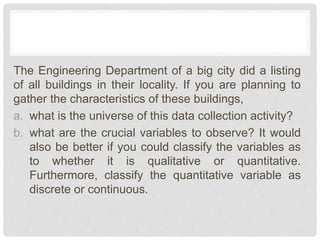Basic Terms in Statistics
- 2. OVERVIEW OF THE LESSON As continuation of Lesson 2 (where we contextualize data) in this lesson we define basic terms in statistics as we continue to explore data. These basic terms include the universe, variable, population and sample. In detail we will discuss other concepts in relation to a variable.
- 3. LEARNING OUTCOMES •Define universe and differentiate it with population; and •Define and differentiate between qualitative and quantitative variables, and between discrete and continuous variables (that are quantitative);
- 5. RECALL 1. Who provided the data? •The students in this class provided the data.
- 6. WHAT? WHAT ARE THE INFORMATION FROM THE RESPONDENTS? • The information gathered include Class Student Number, Sex, Number of Siblings, Weight, Height, Age of Mother, Usual Daily Allowance in School, Usual Daily Food Expenditure in School, Usual Number of Text Messages Sent in a Day, Most Preferred Color, Usual Sleeping Time and Happiness Index for the Day.
- 7. WHAT? WHAT IS THE UNIT OF MEASUREMENT USED FOR EACH OF THE INFORMATION (IF THERE ARE ANY)? • The units of measurement for the information on Number of Siblings, Weight, Height, Age of Mother, Usual Daily Allowance in School, Usual Daily Food Expenditure in School, and Usual Number of Text Messages Sent in a Day are person, kilogram, centimeter, year, pesos, pesos and message, respectively
- 8. DEFINITION OF BASIC TERMS
- 9. UNIVERSE • the collection or set of units or entities from whom we got the data • a universe is not necessarily composed of people. Since there are studies where the observations were taken from plants or animals or even from non-living things like buildings, vehicles, farms, etc. • This set of units answers the first W’s of data contextualization.
- 10. VARIABLE • a characteristic that is observable or measurable in every unit of the universe • the information that you were asked are referred to as the variables of the study and in the data collection activity, we have 12 variables including Class Student Number
- 11. EXAMPLES OF VARIABLE FROM THE ACTIVITY • age, number of siblings, weight, height, age of mother, usual daily allowance in school, usual daily food expenditure in school, usual number of text messages sent in a day, most preferred color, usual sleeping time and happiness index for the day. • these characteristics are observable in each and every student of the class, then these are referred to as variables.
- 12. POPULATION • The set of all possible values of a variable is referred to as a population. • Thus for each variable we observed, we have a population of values. The number of population in a study will be equal to the number of variables observed. • In the data collection activity we had, there are 12 populations corresponding to 12 variables.
- 13. SAMPLE • A subgroup of a universe or of a population is a sample. • There are several ways to take a sample from a universe or a population and the way we draw the sample dictates the kind of analysis we do with our data.
- 16. • A variable takes on several values. But occasionally, a variable can only assume one value, then it is called a constant. For instance, in a class of fifteen-year olds, the age in years of students is constant. • Variables can be broadly classified as either qualitative or quantitative, with the latter further classified into discrete and continuous types
- 18. QUALITATIVE • variables express a categorical attribute, such as sex (male or female), religion, marital status, region of residence, highest educational attainment. • Qualitative variables do not strictly take on numeric values (although we can have numeric codes for them, e.g., for sex variable, 1 and 2 may refer to male, and female, respectively).
- 19. QUALITATIVE • Qualitative data answer questions “what kind.” Sometimes, there is a sense of ordering in qualitative data, e.g., income data grouped into high, middle and low-income status. Data on sex or religion do not have the sense of ordering, as there is no such thing as a weaker or stronger sex, and a better or worse religion. • Qualitative variables are sometimes referred to as categorical variables.
- 20. QUANTITATIVE • (otherwise called numerical) data, whose sizes are meaningful, answer questions such as “how much” or “how many”. Quantitative variables have actual units of measure. Examples of quantitative variables include the height, weight, number of registered cars, household size, and total household expenditures/income of survey respondents.
- 22. DISCRETE • data are those data that can be counted, e.g., the number of days for cellphones to fail, the ages of survey respondents measured to the nearest year, and the number of patients in a hospital. These data assume only (a finite or infinitely) countable number of values.
- 23. CONTINUOUS •data are those that can be measured, e.g. the exact height of a survey respondent and the exact volume of some liquid substance. The possible values are uncountably infinite.
- 25. VARIABLE TYPE OF VARIABLE TYPE OF QUANTITATIVE VARIABLE CLASS STUDENT NUMBER SEX NUMBER OF SIBLINGS WEIGHT HEIGHT AGE OF MOTHER USUAL DAILY ALLOWANCE USUAL DALY FOOD EXPENDITURE USUAL NUMBER OF TEXT MESSAGES SENT USUAL SLEEPING TIME MOST PREFERRED COLOR HAPPINESS INDEX QUALITATIVE QUALITATIVE QUANTITATIVE QUANTITATIVE QUANTITATIVE QUANTITATIVE QUANTITATIVE QUANTITATIVE QUANTITATIVE QUALITATIVE QUALITATIVE QUALITATIVE DISCRETE CONTINUOUS CONTINUOUS DISCRETE DISCRETE DISCRETE DISCRETE
- 26. SPECIAL NOTE For quantitative data, arithmetical operations have some physical interpretation. One can add 301 and 302 if these have quantitative meanings, but if, these numbers refer to room numbers, then adding these numbers does not make any sense. Even though a variable may take numerical values, it does not make the corresponding variable quantitative! The issue is whether performing arithmetical operations on these data would make any sense. It would certainly not make sense to sum two zip codes or multiply two room numbers
- 27. KEY POINTS • A universe is a collection of units from which the data were gathered. • A variable is a characteristic we observed or measured from every element of the universe. • A population is a set of all possible values of a variable. • A sample is a subgroup of a universe or a population. • In a study there is only one universe but could have several populations. • Variables could be classified as qualitative or quantitative, and the latter could be further classified as discrete or continuous.
- 28. ASSESSMENT 1/4
- 29. A market researcher company requested all teachers of a particular school to fill up a questionnaire in relation to their product market study. The following are some of the information supplied by the teachers: • highest educational attainment • predominant hair color • body temperature • civil status • brand of laundry soap being used • total household expenditures last month in pesos • number of children in the household • number of hours standing in queue while waiting to be served by a bank teller • amount spent on rice last week by the household • distance travelled by the teacher in going to school • time (in hours) consumed on Facebook on a particular day
- 30. a. If we are to consider the collection of information gathered through the completed questionnaire, what is the universe for this data set? b. Which of the variables are qualitative? Which are quantitative? Among the quantitative variables, classify them further as discrete or continuous. • highest educational attainment • predominant hair color • body temperature • civil status • brand of laundry soap being used • total household expenditures last month in pesos • number of children in a household • number of hours standing in queue while waiting to be served by a bank teller • amount spent on rice last week by a household • distance travelled by the teacher in going to school • time (in hours) consumed on Facebook on a particular day
- 31. ANSWERS
- 32. A. IF WE ARE TO CONSIDER THE COLLECTION OF INFORMATION GATHERED THROUGH THE COMPLETED QUESTIONNAIRE, WHAT IS THE UNIVERSE FOR THIS DATA SET? (The universe is the set of all teachers in that school)
- 33. WHICH OF THE VARIABLES ARE QUALITATIVE? WHICH ARE QUANTITATIVE? AMONG THE QUANTITATIVE VARIABLES, CLASSIFY THEM FURTHER AS DISCRETE OR CONTINUOUS. • highest educational attainment (qualitative) • predominant hair color (qualitative) • body temperature (quantitative: continuous) • civil status (qualitative) • brand of laundry soap being used (qualitative) • total household expenditures last month in pesos (quantitative: discrete) • number of children in a household (quantitative: discrete) • number of hours standing in queue while waiting to be served by a bank teller (quantitative: discrete) • amount spent on rice last week by a household (quantitative: discrete) • distance travelled by the teacher in going to school (quantitative: continuous) • time (in hours) consumed on Facebook on a particular day(quantitative: continuous
- 34. ASSIGNMENT
- 35. The Engineering Department of a big city did a listing of all buildings in their locality. If you are planning to gather the characteristics of these buildings, a. what is the universe of this data collection activity? b. what are the crucial variables to observe? It would also be better if you could classify the variables as to whether it is qualitative or quantitative. Furthermore, classify the quantitative variable as discrete or continuous.
- 36. ANSWERS
- 37. The Engineering Department of a big city did a listing of all buildings in their locality. If you are planning to gather the characteristics of these buildings, a. what is the universe of this data collection activity? (Set of all buildings in the big city) b. what are the crucial variables to observe? It would also be better if you could classify the variables as to whether it is qualitative or quantitative. Furthermore, classify the quantitative variable as discrete or continuous. (A possible answer is the number of floors in the building, quantitative, discrete)




![[CONSOLIDATED
DATA]](https://izqule7twkl7vq3ljkxejyz-s-a2157.bj.tsgdht.cn/3-200109015159/85/Basic-Terms-in-Statistics-4-320.jpg)
